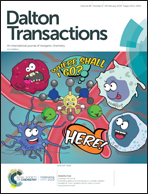Acetate as a model for aspartate-based CXCR4 chemokine receptor binding of cobalt and nickel complexes of cross-bridged tetraazamacrocycles†
Abstract
A number of disease states including WHIM syndrome, HIV infection and cancer have been linked to the chemokine receptor CXCR4. High-affinity CXCR4 antagonist transition metal complexes of configurationally restricted bis-tetraazamacrocyclic ligands have been identified in previous studies. Recently synthesised and structurally characterised Co2+/Co3+ and Ni2+ acetate complexes of mono-macrocycle cross-bridged ligands have been used to mimic their known coordination interaction with the aspartate side chains on binding to CXCR4. Here, X-ray crystal structures for three Co2+/Co3+ acetate complexes and five Ni2+ acetate complexes are presented and demonstrate flexibility in the mode of binding to the acetate ligand concomitantly with the requisite cis-V-configured cross-bridged tetraazamacrocyle. Complexes of the smaller Co3+ metal ion exclusively bind acetate by chelating both oxygens of acetate. Larger Co2+ and Ni2+ metal ions in cross-bridged tetraazamacrocycles show a clear tendency to coordinate acetate in a monodentate fashion with a coordinated water molecule completing the octahedral coordination sphere. However, in unbridged tetraazamacrocycle acetate structures reported in the literature, the coordination preference is to chelate both acetate oxygens. We conclude that the short ethylene cross-bridge restricts the equatorial bulk of the macrocycle, prompting the metal ion to fill the equator with the larger monodentate acetate plus water ligand set. In unbridged ligand examples, the flexible macrocycle expands equatorially and generally only allows chelation of the sterically smaller acetate alone. These results provide insight for generation of optimised bis-macrocyclic CXCR4 antagonists utilising cobalt and nickel ions.



 Please wait while we load your content...
Please wait while we load your content...